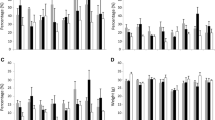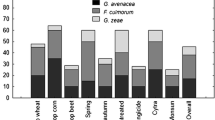Abstract
Disease severity (% of Fusarium-damaged spikelets), disease incidence (% of Fusarium-damaged wheat heads), Fusarium graminearum DNA (pg per ng total DNA), deoxynivalenol (DON) content (mg DON per kg grain dry mass) and yield (t per ha) were recorded in a field experiment carried out in Northern Germany. Plants (susceptible cultivar Ritmo) were inoculated at anthesis by overhead application of a F. graminearum mycelial suspension during a 6.7 mm precipitation event. Fungicides were applied around the time of wheat anthesis to generate different levels of Fusarium-damage. Infected heads were sampled in two-week-intervals post inoculation. Disease incidence increased almost linearly with time, reaching levels of about 80% at four weeks post inoculation. Disease severity increased in a slightly exponential manner with time, reaching levels of about 60% after four weeks. Six weeks after inoculation, Fusarium head blight symptoms could not be distinguished from blighting of wheat heads due to plant senescence anymore. The ratio of F. graminearum DNA and total DNA increased exponentially with time up to four weeks post inoculation. Relationships between fungal DNA and yield or DON were closer when DNA was extracted two weeks post anthesis in comparison with four weeks post anthesis. Hence, quantification of fungal DNA seems to be advantageous for assessing FHB in wheat at early stages of disease development. In the middle of disease development, disease severity allowed the most precise estimation of yield and DON contents. Towards the end of disease development, the DON content was the most useful variable to describe the intensity of Fusarium-damage, because it could be evaluated in senescent plant material. Yield of infected plants increased from about 6.5 to 10 t ha−1 upon fungicide (Caramba, Folicur, or Input) application at two days before or two days after anthesis. Effects were smaller when fungicides were applied earlier or later. At equal application time, equal disease severity level, and equal fungal DNA concentration, effects of fungicides on yield were not significantly different (P = 0.734) whereas effects on the DON content were (P < 0.001). Folicur applied around the time of wheat anthesis decreased the DON content of the grain from about 14 mg kg−1 to 9 mg kg−1 whereas Caramba and Input decreased the DON content to about 5 mg kg−1.
Zusammenfassung
Die Befallsstärke (% Fusarium-befallene Spindelstufen), die Befallshäufigkeit (% Fusarium-befallene Weizenähren), die Fusarium graminearum DNA-Menge (pg pro ng Gesamt DNA), der Deoxynivalenol (DON)-Gehalt (mg DON pro kg Korntrockenmasse) sowie der Ertrag (t pro ha) wurden in einem in Norddeutschland durchgeführten Freilandversuch im Winterweizen erfasst. Die Inokulation der Pflanzen (anfällige Sorte Ritmo) erfolgte zur Blüte durch Ährenapplikation einer F. graminearum Myzelsuspension während eines 6,7 mm Niederschlagsereignisses. Fungizide wurden wenige Tage vor oder nach der Weizenblüte appliziert, um verschiedene Befallsstufen zu erhalten. Die Probennahmen erfolgten in Intervallen von zwei Wochen nach der künstlichen Infektion. Die Befallshäufigkeit stieg mit der Zeit nahezu linear an und erreichte vier Wochen nach der Inokulation etwa 80%. Die Befallsstärke stieg leicht exponentiell an und erreichte vier Wochen nach der Infektion ca. 60%. Eine zuverlässige Unterscheidung von Taubährigkeit und pflanzlicher Senes-zenz war ab 6 Wochen nach der Infektion nicht mehr möglich. Die Beziehung zwischen F. graminearum DNA-Menge und Gesamt DNA stieg exponentiell bis vier Wochen nach der Inokulation an. Die Beziehungen zwischen F. graminearum DNA und Ertrag oder DON-Gehalt waren enger, wenn die DNA-Extraktion zwei Wochen nach der Inokulation erfolgte im Vergleich zu vier Wochen. Demzufolge scheint die Quantifizierung der pilzlichen DNA zur Schätzung der Schädigung von Weizen durch Fusarium-Arten in frühen Stadien der Krankheitsentwicklung von Vorteil zu sein. In der Mitte des Krankheitsverlaufes stellte die Befallstärke den besten Parameter zur Schätzung des DON-Gehaltes sowie des Ertrages dar. Der DON-Gehalt eignet sich insbesondere in der späten Krankheitsentwicklung, um das Ausmaß der Schädi-gung zu quantifizieren, da er problemlos in seneszentem Pflanzenmaterial bestimmt werden konnte. Eine Fungizidbe-handlung (Caramba, Folicur, Input) der infizierten Pflanzen zwei Tage vor oder zwei Tage nach der Blüte konnte den Ertrag im Vergleich zur unbehandelten Kontrolle von ca. 6,5 auf 10 t ha−1 steigern. Die Ertragseffekte fielen geringer aus, wenn die Fungizide vor oder nach diesem Zeitfenster appliziert wurden. Bei gleichem Applikationszeitpunkt, gleicher Befallsstärke sowie gleicher F. graminearum DNA-Menge beeinflußten die Fungizide den DON-Gehalt signifikant (P < 0,001), nicht jedoch den Ertrag (P = 0,734). Die Applikation von Folicur zur Blüte bewirkte eine Senkung des DON-Gehaltes im Korn von ca. 14 mg kg−1 auf 9 mg kg−1, wohingegen Caramba und Input den DON-Gehalt auf etwa 5 mg kg−1 senken konnten.
Similar content being viewed by others

References
Anonymous, 2004: BUNDESGESETZBLATT JAHRGANG 2004 TEIL I NR. 5, AUSGEGEBEN ZU BONN AM 12. FEBRUAR 2004: VERORDNUNG ZUR ÄNDERUNG DER MYKOTOXIN-HÖCHSTMENGENVER-ORDNUNG UND DER DIÄTVERORDNUNG.
Anonymous, 2006: EC 1881, 2006: Festsetzung der Höchst-gehalte für bestimmte Kontaminanten in Lebensmitteln. Amtsblatt der Europäischen Kommission L364, 5–24.
Beyer, M., M. B. Klix, H. Klink, J.-A. Verreet, 2006: Quantifying the effects of previous crop, tillage, cultivar and triazole fungicides on the deoxynivalenol content of wheat grain — a review. J. Plant Dis. Protect. 113, 241–246.
Beyer, M., M. B. Klix, J.-A. Verreet, 2007: Estimating mycotoxin contents of Fusarium-damaged winter wheat kernels. Int. J. Food Microbiol. 119, 153–158.
Beyer, M., J. Aumann, 2008: Effects of Fusarium infection on the amino acid composition of winter wheat grain. Food Chem. 111, 750–754.
Brandfaß, C., 2006: Establishment and application of real-time PCR-based methods to study the epidemiology of Fusarium head blight. Dissertation, University of Göttingen, Germany.
Chen, G. Y. J., S. Jin, P. H. Goodwin, 1999: An improved method for the isolation of total RNA from Malva pusilla tissues infected with Colletotrichum gloeosporioides. J. Phytopathol. 148, 57–60.
Doohan, F. M., D. W. Parry, P. Jenkinson, P. Nicholson, 1998: The use of species-specific PCR-based assays to analyse Fusarium ear blight of wheat. Plant Pathol. 47, 197–205.
Engl, 2005: MINIMUM PERFORMANCE REQUIREMENTS FOR ANALYTICAL METHODS OF GMO TESTING. EUROPEAN NETWORK OF GMO LABORATORIES. http://gmo-crl.jrc.it/doc/Method%20requirements.pdf (accessed 23 Jun 2008).
Fao, 2004: Worldwide regulations for mycotoxins in food and feed in 2003: FAO food and nutrition paper 81. Food and Agriculture Organization of the United Nations, Rome [ftp://ftp.fao.org/docrep/fao/007/y5499e/y5499e00.pdf].
Fredlund, E., A. Gidlund, M. Olsen, T. Börjesson, N.H.H. Spliid, M. Simonsson, 2008: Method evaluation of Fusarium DNA extraction from mycelia and wheat for down-stream real-time PCR quantification and correlation to mycotoxin levels. J. Microbiol. Meth. 73, 33–40.
Guo, J.R., F. Schnieder, J.-A. Verreet, 2006: Presymptomatic and quantitative detection of Mycosphaerella graminicola development in wheat using a real-time PCR assay. FEMS Microbiol. Lett. 262, 223–229.
Klix, M.B., M. Beyer, J.-A. Verreet, 2008: Effects of cultivar, agronomic practices, geographic location, and meteorological conditions on the composition of selected Fusarium species on wheat heads. Can. J. Plant Pathol. 30, 46–57.
Markell, S.G., L.J. Francl, 2003: Fusarium head blight inoculum: species prevalence and Gibberella zeae spore type. Plant Dis. 87, 814–820.
Moreira, D., 1998: Efficient removal of PCR inhibitors using agarose-embedded DNA praparations. Nucleic Acids Res. 26, 3309–3310.
Yi, C., H.P. Kaul, E. Kübler, K. Schwadorf, W. Aufhammer, 2001: Head blight (Fusarium graminearum) and deoxynivalenol concentration in winter wheat as affected by pre-crop, soil tillage and nitrogen fertilization. J. Plant Dis. Protect. 108, 217–230.
Waalwijk, C., P. Kastelein, I. de Vries, Z. Kerényi, T. van der Lee, T. Hesselink, J. Köhl, G. Kema, 2003: Major changes in Fusarium spp. in wheat in the Netherlands. Eur. J. Plant Pathol. 109, 743–754.
Zadoks, C., T.T. Chang, C.F. Konzak, 1974: A decimal code for the growth stages of cereals. Weed Res. 14, 415–421.
Author information
Authors and Affiliations
Corresponding author
Rights and permissions
About this article
Cite this article
Scheider, N., Guo, JR., Verreet, JA. et al. Assessing the intensity of Fusarium-damage in wheat: A comparison of selected disease parameters during disease development and the role of fungicides. J Plant Dis Prot 116, 118–123 (2009). https://doi.org/10.1007/BF03356297
Received:
Accepted:
Published:
Issue Date:
DOI: https://doi.org/10.1007/BF03356297



